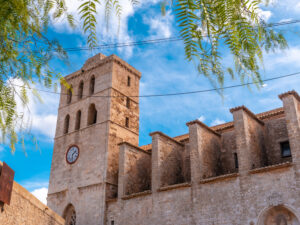Day 1: ORIGIN AIRPORT – TBILISI:
Departure from the origin airport to Tbilisi (Georgia). Assistance at the destination airport and transfer to the hotel. In the afternoon, city tour. Dinner and overnight in Tbilisi.
Day 2: TBILISI – KAKHETI – LAND OF WINE – TBILISI:
Tour of Kakheti, the most fertile and picturesque part of Georgia. Kakheti is located next to the great Caucasus Mountains, north of the Alazani Valley, with peaks exceeding 3,000 meters in height. This region is the birthplace of winemaking. The rich soil, blazing sun, and hard work have developed around 500 different types of wine in Georgia. Visits: Bobde nunnery, the royal town of Signagi with its 23 towers, the Tsinandali Family Estate, and the architectural complex of Gremi (16th-17th centuries). Lunch at a local restaurant. (*Wine tasting can be arranged for an additional fee). Return to Tbilisi for dinner and accommodation.
Day 3: TBILISI – SADAKHLO – HAGHPAT- AKHTALA – HOVHAN- NAVANK:
After breakfast, we will transfer to the Sadakhlo border. Assistance at the border, change of guide and vehicle, and entry into Armenia. Customs procedures. Visit to the city of Alaverdi and the Haghpat Monastery (10th-13th centuries). Celebration of the Eucharist. Lunch at an ECO restaurant with panoramic views of the Debed Canyon. Departure to the Lori region to visit the fortified Akhtala monastery from the 10th century, 185 kilometers north of Yerevan. The main church is famous for its high-quality artistic frescoes. Later, we will visit the Hovhanavank Monastery (4th century) in the Aragatsotn province. Arrival in Yerevan. Dinner and accommodation.
Day 4: YEREVAN. GEGHARD MONASTERY. – GARNI TEMPLE:
After breakfast, we will tour the city and ascend to the highest point for the panoramic view: Cascade, City Park, Abovyan Street, Republic Square, etc. Then visit the Manuscript Museum, Matenadaran, which preserves 14,000 ancient manuscripts, the largest collection in the world. Visit the Cascade and the Gafesjian Contemporary Art Center, a building designed by architect Alexander Tamanyan (1878-1936) to connect the historic district with the city’s cultural centers.
Next, we head to the Kotayk region. Lunch in a rural house/restaurant to learn about the preparation of “lavash” (Armenian bread) in a traditional underground oven, “tonir.” The meal will be a traditional barbecue (fresh marinated lamb or pork, chicken or rabbit), potatoes, and seasonal vegetables (peppers, eggplants, tomatoes) prepared in the Tonir. The group can participate in the preparation/cooking of these typical and delicious Armenian dishes, enjoying the most traditional Armenian food. Then, visit the Pagan Garni Temple (1st century BC) dedicated to the sun god Mithra and a UNESCO World Heritage Site. The location is impressive, with canyons and landscapes, Khosrov State Reserve. Ride in Soviet military cars through the Garni slope, called the “Symphony of Stones,” composed of basalt column formations. Return to visit the Geghard Monastery, a UNESCO World Heritage Site. There, we can listen to a Vocal Concert of medieval Armenian music. (15-20 min). The Monastery is built into the mountain and has unbeatable acoustics. Return to Yerevan. Dinner and accommodation.
Day 5: YEREVAN – ECHMIADZIN – KHOR VIRAP – YEREVAN:
Breakfast at the hotel. We will travel to the Echmiadzin complex, the seat of the catholicos or main patriarch of the entire Armenian Apostolic Church, the first country to declare itself Christian in the early 4th century. Visit to the Museum of Armenian Treasures. Then, we will visit the ruins of the Zvartnots Cathedral, a UNESCO World Heritage Site (7th century). Lunch at CUA (Cross of Armenian Unity – www.cau.am). Then we will head south to see the biblical Mount Ararat. Visit to the Khor Virap monastery, near the border with Turkey. This monastery is located on the left bank of the Arax River, at the foot of the biblical Mount Ararat, on a hill where the citadel of the ancient Armenian capital Artashat once stood. Its name means Deep Well and is closely linked to the figure of St. Gregory the Illuminator. It has special cultural and historical importance for Armenia. From here, we can see the impressive view of Mount Ararat. Near the monastery, we can release white doves as a symbol of peace. Return to Yerevan. Dinner and accommodation.
Day 6: YEREVAN – LAKE SEVAN – DILIJAN – TBILISI:
Breakfast and departure from the hotel to visit Tsitsernakaberd (Monument and museum dedicated to the victims of the 1915 genocide). Then we will head towards Lake Sevan, the second largest alpine lake in the world, located at 2000 meters above sea level. Visit the 9th-century monasteries located on the peninsula. Lunch at a local restaurant, where we will taste fish from the lake. Continuing on to the spa town of Dilijan (known as Little Switzerland for its abundant vegetation), we will visit its historic center, now home to an Ethnographic District (www.tufenkianheritage.com). As an alternative activity, we offer the possibility to meet some masters of ethnic art living in the city. We will continue our journey passing through villages where members of the minority ethnic group of the Molokans (in Russian “milk drinkers”) live. They form a minority Christian group that evolved from the idea of the “spiritual Christian.” They were originally Russian peasants who refused to obey the Russian Orthodox Church from the 17th century onwards and still maintain more or less the same lifestyle and religious beliefs and habits, almost as they did 300 years ago. There are only 2 or 3 villages inhabited by Armenian Molokans (there are a few more in other parts of the world). We will reach the border between Armenia and Georgia (Sadakhlo), and once all customs formalities have been completed, we will change guide and vehicle to continue to Tbilisi. Arrival in Tbilisi and dinner at a restaurant. Accommodation in the capital city of Georgia.
Day 7: TBILISI – MTSKHETA – TBILISI:
Visit to Tbilisi, the capital of Georgia, founded in the 5th century by King Vakhtang Gorgasali. Eucharist at the Catholic cathedral. Walk through its old town, called Kala, which expanded within the walls to the banks of the Mtkvari River. Visits: the Metechi Church (12th-13th centuries), the bathhouse district, the Sioni Cathedral (7th-19th centuries), the Anchiskhati Basilica and its bell tower (6th-18th centuries), and the State Museum of History. In the afternoon, we will visit the ancient capital, Mtskheta, inhabited since the 2nd millennium BC. Currently, Mtskheta is considered a UNESCO World Heritage Site, and it is truly a living museum with many architectural and historical monuments. Visits: the Jvari Church (6th-7th centuries) and Svetitskhoveli (11th century), the main church of the city and the place where Christ’s tunic is kept. Lunch at a local restaurant. We will return to Tbilisi for dinner and accommodation.
Day 8: TBILISI AIRPORT – ORIGIN AIRPORT:
Breakfast and transfer to the airport for the flight back to the origin airport. End of the trip and our services.




